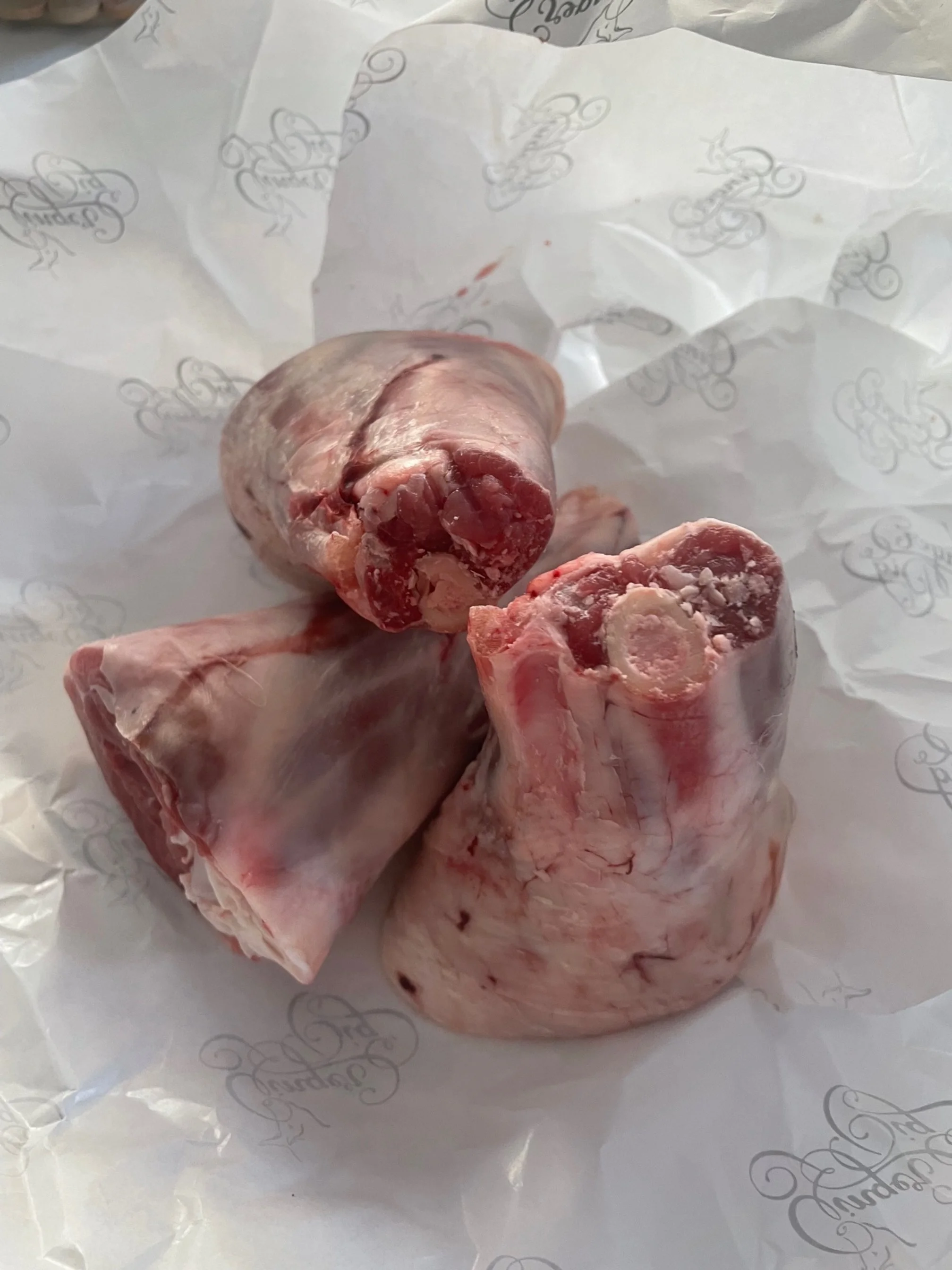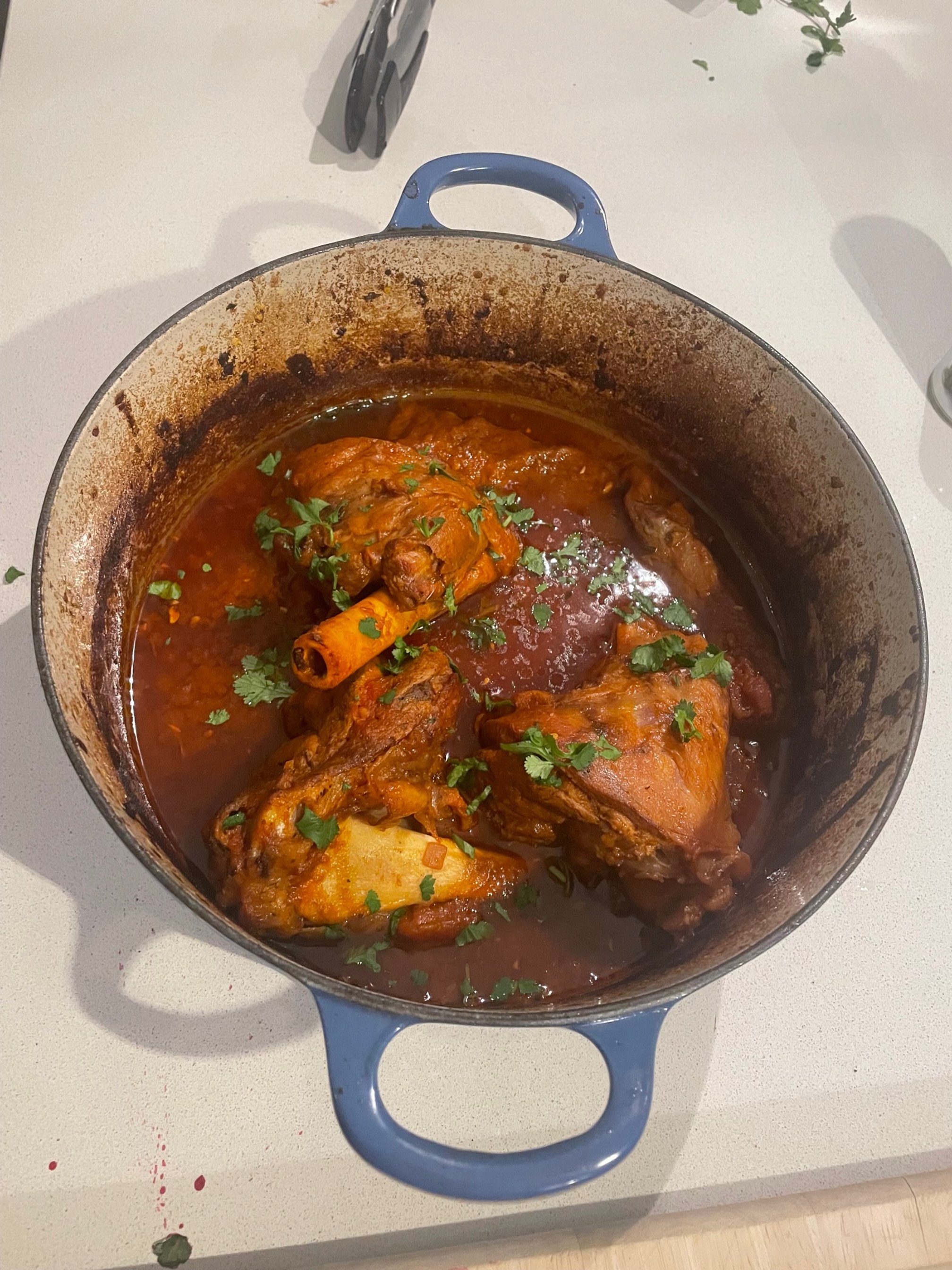Labour of Love Lamb: Teevan, A Traditional Sindhi Curry
I’ve been married for 20 years. The only advice I’ll impart is to have a trick up your sleeve that is your sure-fire way out of the penalty box. For me, atonement through food seems to work. Cooking Teevan, a traditional Sindhi curry, is my proof of ‘I love you’ when the words are so worn, they no longer resonate.
I hate lamb and of course, it’s his favourite.
When raw, lamb smells of smelted iron, sulphur, and organic muck married together. It makes me sick to say this because what is worse: you need lamb shanks (1-2 per person), which are as ugly as they are odorous and remind me of tenth-grade biology. The muscle is so obvious, the layer of membrane covering it even more pronounced, and then there is the bone. The bone has been sawn off, a rough-hewn edge just above where I imagine a fluffy white lamb ankle to be. Thankfully, the key to successful cooking involves not touching the pot too much or opening the lid before that smell is gone.
The use of a pressure cooker, a desi kitchen staple is usually advised, rendering a slow cooked, deep flavoured stew fast. I remember the sharp whistle from Mom’s kitchen, her warning to stay far away from it, lest I burn myself with the steam forced through the screeching whistle.
To this day, the vessel fills me with fear. Thus, I adopted a Western tradition: a Dutch oven in the actual oven. When finished, a Boeuf Bourguignonne, for instance, has a glossy, unctuous look, not dissimilar from what I am after. Using a Dutch oven to get a slow-cooked, deep-flavour, native curry, tastes better, has the benefit of ‘set it and forget it.’
I want to say I love you, but I don’t want anything too fiddly, or am bound to get it wrong and blow the moment.
Just like a slow cooker chili, ideally, you start the Dutch oven on the stove. It is more effort, more cleaning. On occasion, driven by empathy over cleaning, rather than laziness, I have put everything in the Le Creuset, raw, straight into the oven. The smell of the finished product is leaner, simpler, yet quite passable. I think only I can tell the difference. After all, his palate is one accustomed to shepherds’ pie, Lancashire hotpot, the curries from the takeaway.
However, today is for grand gestures, multi-faceted feelings through flavour; I’ll go through the extra step.
The birth of a good curry is the Indian version mire poix: garlic, onions, ginger, frying it in oil on the stove. Next, I add the whole spices: cinnamon, cardamom, cloves, peppercorns, cumin, and a dried red chilli. Then the ground spices go in: turmeric, coriander, chilli powder. When the toasted scent of the mixture starts to be noticed in other rooms in the house, the wet ingredients can be added. In go chopped chilis, tomatoes, yogurt and finally, the shanks. I may have been told yogurt masks the metallic smell from the lamb. I dollop in an extra spoonful, trying not to inhale too deeply. Everything needs caramelisation; it needs to meld together in harmony, on the stove.
Of course, don’t forget the salt. Don’t forget not to make it too salty. He complains when anything is too salty.
Quantities and cooking times have never been measured or recorded for generations of us cooking this dish. The best advice is to use your senses, the mixture will smell right. A small amount of water might pool on the tongue if lamb is your thing. In my case, I know at the moment he comes down to the kitchen. Lured by the aroma, his frame in the kitchen door says it is time to transfer the pot with the lid on to the oven.
He offers to clean up as I cook, per usual. I am caught like a guilty child at the number of things that are covered in a thin film of meat grease, splodges of half-cooked curry base, tell-tale yellow streaks of turmeric. I chase him away; I can clean up after myself as the curry is in the oven for at least a few hours.
In fact, I may have over-estimated the labour part, other than removing the Dutch oven which, once filled, has the weight of an eighteen-month-old.
The curry is done when I smell the cinnamon note above the others. That smell reminds me I forgot the bay leaves.
Curries are very forgiving. Bay leaves are a necessary, delicate back-note. As I take out the pot from the oven to add the forgotten hero, I have an opportunity to assess the situation. I may turn the shanks. I check the water’s edge along the inside of the pot. If it looks carbonised, burned, ruined, then there isn’t enough liquid. It’s a good moment to add a bit of water for enough gravy, ras, in our language. Funny, that ras, can also mean ‘juice.’ Leave the heat if there is added water, off if not. Either way, it might look like a failure because the meat does not fall off the bone. Stubbornly stuck as if muscle is still controlled by a life force, despite being a severed article. Pot in the oven with the heat turned off, I wait for the lamb to become tender, the flavour of the late-addition bay leaves to permeate.
At this point I am overtaken by heaps of emotions, unrelated to cooking. I am frustrated by the lack of a conventional recipe. I am annoyed at my patchy memory of my mother’s cooking, which leads me to alter, add, hope it is enough, try to catch the elusive taste of my youth.
My fretful mind needs an outlet when, it suddenly remembers the why of it all. I am preparing a culinary ‘I’m sorry for working too hard, for snapping at you in the morning before my coffee, for putting lots of things ahead of you, for not really listening or remembering what you said yesterday at dinner, for not filling the car with petrol even though it’s on a quarter tank, for leaving my clothes on the bathroom floor over the last few days, or for any other reason I’m getting that look, that exhausted sigh.’
Perhaps a home-made naan bread; the oven is on anyway - saves him a trip to buy some from the neighbourhood take-away. Some roasted papads. A cucumber raita. A quick pickled onion. A beetroot garnish/salad. Sliced up cucumbers for hungry children, in need of something but not too much. Poor things must wait for the promised dinner to tenderise.
There must be rice. If I hadn’t been distracted by a dozen other things, I might have put the rice on earlier. I make vegetable side dishes for the child who hates lamb as much as I do.
Finally, it is done. The meat on the shanks has given up its grip on the bone, being neglected in the cooling, forgotten oven. It falls off into long strips with the slightest pressure of a fork. The bones have thickened and flavoured a complex sauce. The accompaniments are an embarrassment of riches.
He directs a happy sigh, a grateful glance, towards me. I return a fond smile, and intake a volume of breath as I feel the weight of my success, and the slight embarrassment of having left a mess of pots and pans for him to attend to after all.
Incidentally, lamb neck fillets work a treat: they don’t smell as much, and take far less time to tenderise, but there is something in his DNA which seems to require a bone-in version. Given I won’t eat much of either, it makes no difference to me.
Written by Anu Pohani
I am an Asian-American living in London with my family and Alfie, the Tibetan terrier. My essays and short stories have appeared in Entropy, Untitled Voices, and Honey Literary, among others. I can be found on Twitter @AnuPohani.










